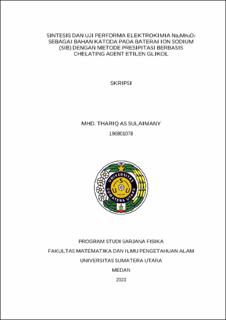Sintesis dan Uji Performa Elektrokimia Na2Mn3O7 sebagai Bahan Katoda pada Baterai Ion Sodium (SIB) dengan Metode Presipitasi Berbasis Chelating Agent Etilen Glikol
Synthesis and Electrochemical Performance Tests Na2Mn3O7 as A Cathode Material in Sodium Ion Batteries (SIB) Using The Precipitation Method Based on Ethylene Glycol Chelating Agent

Date
2023Author
Sulaimany, Mhd Thariq As
Advisor(s)
Humaidi, Syahrul
Subhan, Achmad
Metadata
Show full item recordAbstract
Tests have been carried out on the electrochemical performance of NaxMnyOz as a cathode ion material in sodium ion batteries. This research aims to synthesize NaxMnyOz precursor as a cathode in sodium ion batteries. The manufacturing process uses commercial MnCO3 and synthetic MnCOx material variants. In the first sample, namely sample Tq-1, it is made from commercial MnCO3, while the second sample, namely Tq-3, is made from MnCOx which is synthesized from MnSO4.1H2O and Na2CO3. Both variants are mixed with Na2CO3 to become NaxMnyOz precursor. Next, the precursor is sintered, namely heating the material using a furnace at a temperature of 700ºC over a period of 4 hours. The precursor is then ground with a mortar and then sieved with a 400 mesh sieve to make it smooth. Make a slurry by mixing the active materials: PVDF: Super P in a ratio of 8: 1: 1 and 3.5 ml of NMP. The EIS results obtained for sample Tq-1 had a conductivity value of 3.4706 x 10-7 S/cm and Tq-3 was 2.7304 x 10-7 S/cm. In the CV test, the oxidation peak was found to be 2.77 V and the reduction peak was 1.62 V at Tq-1, and at Tq-3, the oxidation peak was 2.842 V and the reduction peak was 1.716 V. In the CD test, the maximum peak reached the Tq-1 sample. 4.3 V and a minimum of 1.4 V, while the Tq-3 sample was able to reach a maximum peak of 4.2 V and a minimum of 1.3 V. The Tq-1 capacity was 117.02 mAh/g on charge and 93. 47 mAh/g on discharge, while the Tq-3 has a capacity of 79.17 mAh/g on charge and 65.79 mAh/g on discharge. The results show that Tq-1 samples are better than Tq-3.
Collections
- Undergraduate Theses [1307]
